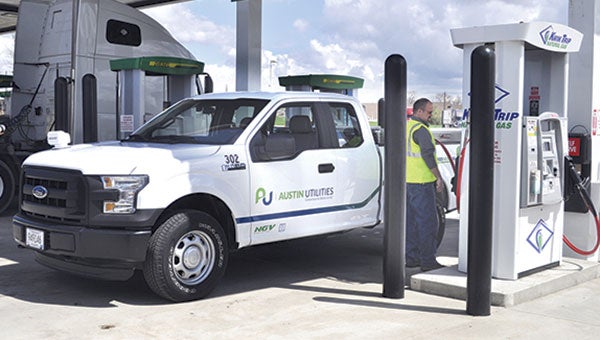Austin Utilities goes green for Earth Day
Published 10:10 am Friday, April 22, 2016

Natural Gas Supervisor Rob Gleason fills up the new compressed gas vehicle purchased by Austin Utilities at Kwik Trip’s natural gas pump. Jordan Gerard/jordan.gerard@austindailyherald.com
Austin Utilities filled up one of its new trucks at the 10th Place Northeast Kwik Trip yesterday for the first time, but not with unleaded gas.
The 2016 Ford F-150 was bought as a replacement for a retired vehicle and is capable of running on compressed natural gas, which has advantages of reducing environmentally harmful emissions, General Manager Mark Nibaur said.
“We thought it was a good time for us to start looking at those opportunities for energy efficiency, as well as economics, as well as the environment. And so we wanted to get our first vehicle,” Nibaur said.
Natural gas vehicles emit 90 to 97 percent less carbon monoxide, 25 percent less carbon dioxide, 35 to 60 percent less nitrogen oxide and reduce noise emissions by 80 percent compared to a diesel engine. They’re also safer due to a thicker fuel storage tank, according to a press release.
Kwik Trip Territory Manager of Commercial Fuels Danny Claussen said the compressed part of “compressed natural gas” is a pressure that allows it to move through the system.
“It’s different from liquid natural gas because liquid natural gas will vaporize and actually vent to the atmosphere,” Claussen said. “Compressed natural gas won’t do that. It’s a much more stable fuel.”
Compressed natural gas is a by-product of drilling for regular gas and it doesn’t have to be transported to the store, because the store already uses it, Claussen said.
Nibaur said they’re excited to add the truck to their fleet and use a local station to fill it up.
“We’re probably going to run this vehicle for a year or two and see how it operates,” Nibaur said. “At this point it seems to be running very smoothly, very efficient so we’re probably going to operate it for a year or two but our plan is to add more if the vehicle works out in our fleet.”
Claussen said the truck’s tank is 19 gallons and it gets the same fuel economy as if it were to run on liquid gasoline, maybe “just a little better.”
“It runs quieter, it runs a little bit hotter and it’s much more aggressive,” Claussen said. “You couldn’t tell driving it that it was running on natural gas or regular gas.”
The vehicle cost about $32,000 to buy, including the natural gas kit. Nibaur said the payback depends on the cost of gasoline, which for natural gas is $1.99 per gallon, whereas regular unleaded gas is currently $2.09.
Nibaur said the most important thing about the truck is the environmental impact.
“It runs very smooth,” Nibaur said. “[It’s] very clean, almost 50 to 80 percent cleaner than a regular gasoline vehicle, so that’s important to us as well.”
Claussen added it’s still pretty rare to see vehicles running on compressed natural gas, though he himself owns a Chevy Impala with the equipment to run on compressed natural gas.
The truck Austin Utilities purchased runs only on compressed natural gas, but Claussen said other vehicles of this type are often bi-fuel, so if the CNG runs out, the car can run on liquid gas.





